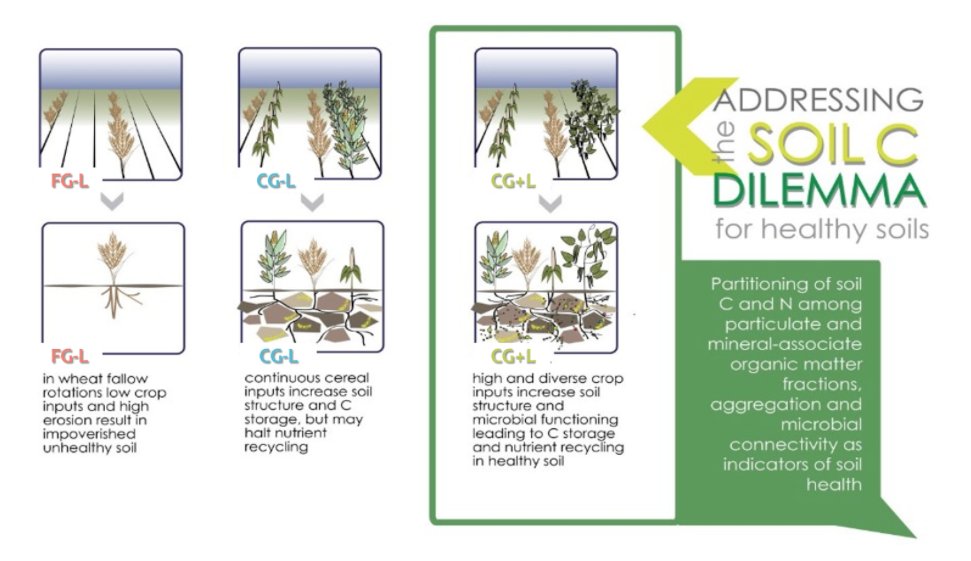
Give peas a chance: building soil health and maintaining yields in drylands
Publication Brief by Laura van der Pol | February 19, 2022
Some farmers in Colorado and Nebraska have found a way to rebuild their soil by growing a new crop: peas. Researchers at Colorado State University conducted a study involving farmers and long-term agricultural research sites to assess the soil organic matter under three contrasting no-till rotations: wheat-fallow, continuous grain (no legume: CG-L), and continuous grain with legume (CG+L). They found that when farmers had the leguminous pea crop in rotation, soil organic matter (0.76 lb ac-1) was higher than in the conventional wheat-fallow rotation common to the region. Their study and findings were recently published in the journal Agriculture, Ecosystems, and the Environment.

As some of the farms sampled in this study had only been through their rotation cycle a couple times, the boost in organic matter and sustained yields was encouraging. Rebuilding organic matter is challenging in this semi-arid region due to limited moisture. While leaving fields fallow for fourteen months does leave more water available for a wheat crop, previous research has shown that most of the water evaporates whether or not there’s a crop in the ground. In recent decades, more farmers have eliminated the fallow period in favor of continuous cropping where a crop is planted every year. As this study confirmed, continuous cropping is more productive than the wheat-fallow when crop yields are considered over the full rotation. Continuous cropping (CG-L) alone, however, did not always lead to gains in soil organic matter. Including a legume in the rotation changed that.
What’s the big deal about SOM?
Organic matter provides energy as carbon compounds to sustain the microbial communities who supply nutrients (especially nitrogen) essential to plant growth through decomposition. It also improves the soil structure, enables soils to hold more moisture, and could be a tool to combat climate change as increasing soil organic matter makes farms more resilient to extreme weather and removes carbon from the atmosphere.
How could legumes make a difference?
These findings suggest that the chemistry of the crops grown might be important for how much soil organic matter forms and persists in these semi-arid systems. Why would the legumes make a difference? Legumes are plants that partner with bacteria to fix nitrogen from the atmosphere. As a result, legumes have a higher nitrogen content than other plants such as wheat or corn. When the roots and leaves of the legume decompose, this plant material is a rich food-source for soil microbes. Just as you would grow more on a diet of macaroni than salad greens, microbes feeding on legume tissues can grow more and more efficiently than when feeding on crop residues like wheat and corn. That means they spend less energy (carbon) to meet their metabolic needs and to reproduce. When the microbial community grows, so does the amount of dead microbial cells and byproducts, and the carbon and nitrogen from microbial products is in a form that tends to accumulate in the agricultural soils as organic matter.
The researchers studied this by examining fractions of the soil with distinct physical and chemical characteristics. They found that the fraction that forms largely from microbially-processed materials called mineral-associated organic matter (MAOM) was the greatest in the farms that had legumes in the rotation. This form of organic matter resists further microbial consumption and thus can persist in soils for centuries. In this way, the researchers say planting legumes into continuous grain rotations ‘solves’ what’s been termed the “soil carbon dilemma”. The dilemma with soil carbon is analogous to the cake cliche: we want to have it in the soil but have the microbes eat it, too. Farmers want plenty of organic matter in their fields since it improves the soil structure and water infiltration. They also want that organic matter to decompose (e.g. be consumed by microbes) so that nutrients are made available to crops which acquire at least half of their nitrogen from the soil (as opposed to fertilizers).
Results of this study suggest that having a legume in a continuous rotation may solve this dilemma. Commodity crops such as wheat and corn supply the bulk of carbon-rich materials as roots and stubble left on the field, thus providing energy microbes need consistently over time and helping sustain high yields. The legume crop (peas in this study) provides a residue that promotes efficient growth by microbes that more readily forms mineral-associations. Since MAOM requires more energy to break down, it tends to accumulate in the soil over time.
Why is this study important?
These results are important because it shows one way in this water-scarce region that farmers can improve their soil health. That will become increasingly important as climate change intensifies and droughts and extreme temperatures become more common. Having more organic matter in the soil as well as greater diversity of crops are important strategies for farm resilience. Planting peas can help achieve both of these goals.
Citation:
van der Pol, L., Robertson, A., Schipanski, M., Calderon, F., Wallenstein M.D., Cotrufo, M.F. (2022) Addressing the soil carbon dilemma: Legumes in intensified rotations regenerate soil carbon in semi-arid dryland wheat farms. Agriculture, Ecosystems, & the Environment, 107906: 107906. doi: 10.1016/j.agee.2022.107906.